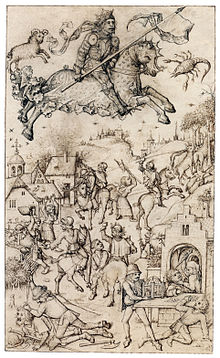
Johann Christoph Volkamer was a German merchant, manufacturer and botanist.

Albert Grünwedel was a German Indologist, Tibetologist, archaeologist, and explorer of Central Asia. He was one of the first scholars to study the Lepcha language.

The August Kestner Museum, previously Kestner-Museum, is a museum in Hanover, Germany. Founded in 1889, the museum was renamed in December 2007 to avoid confusion with the Kestnergesellschaft, a local art gallery.
Heinrich Ludwig Julius Heppe was a German Calvinist theologian and church historian.
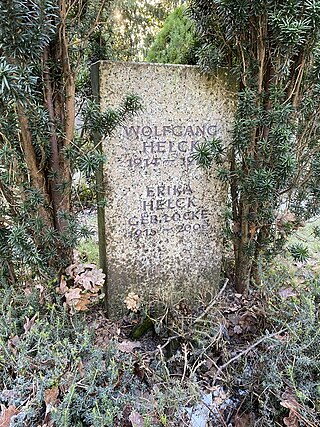
Hans Wolfgang Helck was a German Egyptologist, considered one of the most important Egyptologists of the 20th century. From 1956 until his retirement in 1979 he was a professor at the University of Hamburg. He remained active after his retirement and together with Wolfhart Westendorf published the German Lexikon der Ägyptologie, completed in 1992. He published many books and articles on the history of Egyptian and Near Eastern culture. He was a member of the German Archaeological Institute and a corresponding member of the Göttingen Academy of Sciences.

The House of Waldburg is a princely family of Upper Swabia, founded some time previous to the 12th century; some cadet lineages are comital families. As one of a small number of mediatized houses, the family belongs to the High nobility.

The Südkurier is a regional daily newspaper in Germany serving the regions northwest of Lake Constance, Hochrhein and Black Forest with its headquarters in Konstanz. The paper appears with a circulation of around 130,000, six times per week, in Berliner format. The predecessor of the Südkurier was the Konstanzer Zeitung.

Burgruine Landsee is a ruined castle located in the middle of the Austrian state of Burgenland, east of the village of Landsee in the Markt Sankt Martin municipality in the Oberpullendorf district. It is one of the largest castle ruins in Central Europe. Burgruine Landsee stands 537 metres (1,762 ft) above sea level.
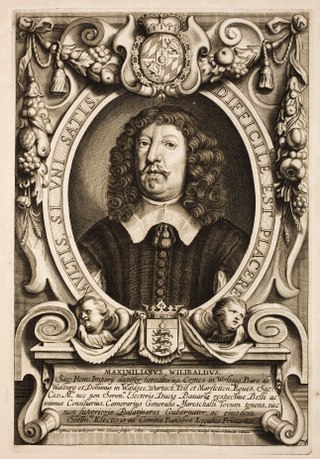
Maximilian Willibald of Waldburg-Wolfegg (1604–1667) was the head of the house of Waldburg-Wolfegg, military commander and the governor of Upper Palatinate for the Electorate of Bavaria. Today however he is mostly remembered as an art collector and for having founded the Wolfegger Kabinett.
Carl Schmidt was a German Coptologist. He made editions of various Coptic texts, and was active in Egypt in purchasing papyri for German universities. He also assisted Sir Chester Beatty in his papyri purchases.

Schloss Muskau is a schloss in the Görlitz district in the state of Saxony, Germany. It is located in an extended park, the Muskau Park, since July 2004 a UNESCO World Heritage Site. The building complex was developed over a long period. The present main building, called Neues Schloss, was built in the 19th century in Neo-Renaissance style, burnt down in 1945, and after decades as a ruin, was reconstructed until 2013.
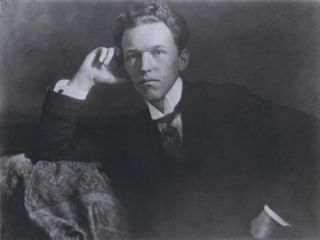
Sigwart Botho Philipp August zu Eulenburg, Count of Eulenburg was the second son of Philipp, Prince of Eulenburg (1847–1921) and his wife Augusta, born Countess of Sandels (1853–1941) and a German late romantic composer who fell in the First World War.
Karl Günther Ernst Felix Becker was a German art historian, best known today for the project Thieme-Becker.
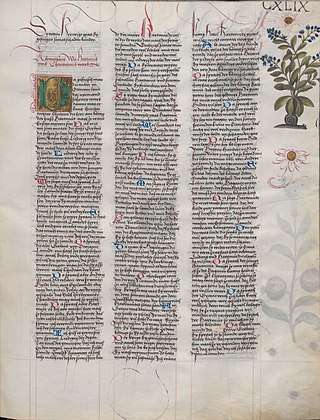
The Ambraser Heldenbuch is a 16th-century manuscript written in Early New High German, now held in the Austrian National Library. It contains a collection of 25 Middle High German courtly and heroic narratives along with some shorter works, all dating from the 12th and 13th centuries. For many of the texts it is the sole surviving source, which makes the manuscript highly significant for the history of German literature. The manuscript also attests to an enduring taste for the poetry of the MHG classical period among the upper classes.

Castle Dyck is a moated castle in the Rhineland region of Germany. It is located in the municipality of Jüchen in Rhein-Kreis Neuss, North Rhine-Westphalia, between Grevenbroich and Mönchengladbach.
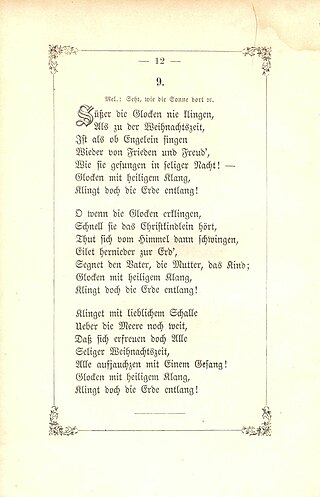
"Süßer die Glocken nie klingen" is a popular German Christmas carol with text by Friedrich Wilhelm Kritzinger to a traditional Volkslied melody, first printed in 1860. It has remained popular and is part of many song books and Christmas recordings, evoking the sound of bells as a symbol of peace and joy.

Eugen Fehrle was a German philologist who specialized in classical and Germanic philology.

Eduard Adolf Daelen was a German painter and writer. For some of his writings he used the pseudonyms Ursus teutonicus, Angelo Dämon, Edu Daelen-Bachem and Michel Bär. He became known above all for the first biography of Wilhelm Busch, which he wrote in 1886.

The Codex Sangallensis 902 is a 186-page long manuscript written mid-9th century at the Abbey Library in St. Gallen, where it is still housed today. The pages are made of parchment, with a height of 32 cm and a width of 25 cm. The text was written in Carolingian minuscule and is typically split into two columns, with 35 lines per column. However, the text is structured in a single column in pages 153 through 179. Titles were written in rustic capitals, whilst chapter initials are in upper case. The illustrations were made by quill in a dark-brown ink, and they often go across their respective columns.

The Staffort Book is a religious-historical work that was printed in 1599 in the Staffort Castle printing house and is regarded as an attempt by Margrave Ernst Friedrich von Baden-Durlach to reconcile Lutheran and Calvinist doctrine. A translation into modern English is available.
